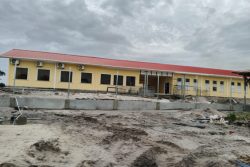Governments of the region have been advised to be transparent with their people about the mosquito-borne chikungunya virus and have been told that as fast as new information surfaces it should be disclosed, Caribbean Public Health Agency (CARPHA) Executive Director Dr. James Hospedales said yesterday.
Recently, there have been complaints here from the private sector and persons infected with the viral disease that the health authorities have been suppressing figures about the number of chikungunya cases. During an interview with Stabroek News yesterday, Dr. Hospedales, responding to a question, said that Guyana and other countries have been addressed on releasing information.
“We advise all government to be transparent with people about whatever health conditions are being experienced and as fast as new information comes to light that information should be made available,” he said, while noting that sometimes there is a lag occurring at the community level— where people would not go to the doctor; where doctors would not tell them what is going on— and as such discrepancies are created.

Dr Hospedales, who was in the country for Caribbean Wellness Week activities, said the number of people infected will continue to rise in the next few months and he therefore urged countries to step up their vector control and public education on the virus.
“The threat from dengue has been building for many years and it has been gradually getting more frequent and more severe,” he said, while adding that it was a signal that “what we have been doing hasn’t been working properly and now on top of that chikungunya arises.”
He said in six months the chikungunya disease has spread from where it was first spotted in St. Martin to nearly all Caribbean territories. “That indicates that it is a significant challenge for us,” he said.
He stated that once several persons with chikungunya have had their diagnoses confirmed through testing in an area within a country, then testing would only be carried out for certain groups of people based on clinical symptoms. Therefore it was not necessary to test every single case.
“Most of the countries are making a valiant effort while some are strapped or lack resources to do so… there are several aspects to deal with this— one is government and what it can do, but most of the time what is needed is for people to take responsibility to clean up their own yards,” he said, while noting that the major sources of mosquito breeding in the Caribbean are water drums and tanks that are not covered, blocked drains and tyres.
Dr. Hospedales said public awareness needs a continuous effort. “I’m calling for a partnership between the government and private sector,” he said. He stated that if there is an outbreak then there would be need for fogging machines, and in particular hand held and truck mounted fogging machines.
He said CARPHA was offering services where government could send mosquito eggs to the laboratory and they will hatch them and test them to see what insecticides the mosquitoes are sensitive to, so “that way the national programme can be more cost effective.”
“Sometimes people are spraying and mosquitoes are laughing because they are resistant to the spray,” he said, before adding that countries need to implement old legislation where people are fined for having mosquito breeding sites in their yards. “Those kinds of penalties need to be brought back to deter people from littering,” he said.
Sanitation inspectors who used to visit premises regularly to check on the conditions of yards are a thing of the past in Guyana.
Chikungunya, a viral disease, is carried by the aedes aegypti mosquito and causes severe joint pains, muscle pains, sudden high fever, headaches and rash. The disease is similar to Dengue Fever and usually surfaces between four to seven days after a bite from an infected mosquito. It lasts for three to 10 days.
PAHO Country Repre-sentative Dr. William Adu-Krow had told Stabroek News that there were 81 confirmed cases and 500 suspected cases of the virus in Guyana. In recent weeks many people have complained about and visited hospitals with symptoms of what appeared to be the viral disease. Medical sources say it is likely that the number of suspected cases is far above 500.







